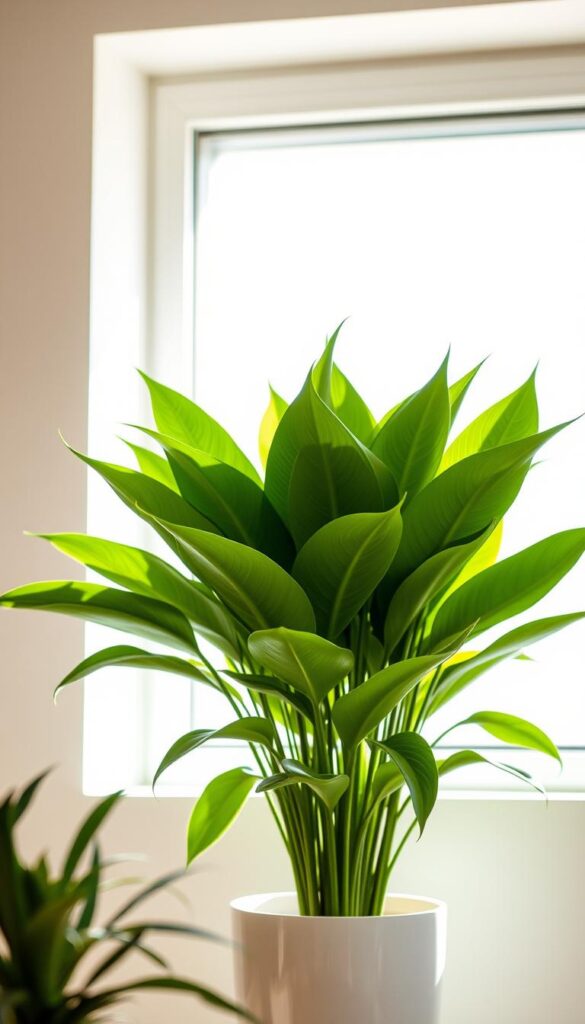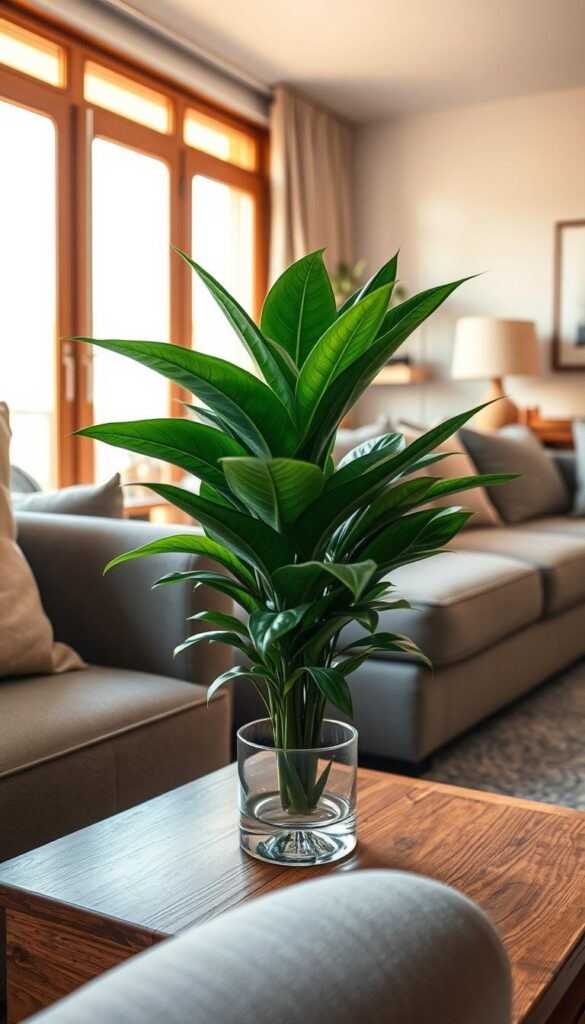My journey with the ZZ plant began in a small, low-light Brooklyn apartment. This nearly indestructible houseplant not only survived but thrived, sparking my confidence as a new plant owner. Its ability to flourish in tough conditions makes it a perfect choice for urban spaces.
The ZZ plant’s glossy foliage and robust growth, even with minimal care, is a testament to its resilience. This article will explore the ideal climate conditions, including temperature, humidity, watering, and soil care. I’ll share practical tips, troubleshooting advice, and seasonal adjustments to help you create the perfect environment for your ZZ plant.
Understanding the Origins and Unique Benefits of the ZZ Plant
My fascination with the ZZ plant began when I discovered its remarkable ability to thrive in challenging environments. Native to the tropical regions of East Africa, this plant has evolved to survive in harsh conditions, making it a perfect choice for indoor spaces.
Natural History and African Origins
The ZZ plant, scientifically known as Zamioculcas zamiifolia, hails from the tropical regions of Kenya to South Africa. It belongs to the Araceae family, which also includes peace lilies. In the wild, it grows in shaded areas with limited water availability, which has contributed to its hardy nature.
Why I Fell in Love with the ZZ Plant
I fell in love with the ZZ plant for its striking, glossy leaves and cycad-like appearance. Its ability to propagate from fallen leaflets adds to its uniqueness. While it’s often said to survive in a closet, it truly shines in indirect light, making it ideal for beginners.
| Characteristic | Details |
|---|---|
| Origin | Africa (Kenya to South Africa) |
| Scientific Name | Zamioculcas zamiifolia |
| Family | Araceae |
| Propagation | From fallen leaflets |
| Light Preference | Indirect light |
Essential Climate Conditions for Optimal ZZ Plant Growth
Creating the right environment for your ZZ plant involves balancing temperature, humidity, and light. These factors play a crucial role in ensuring your plant stays healthy and thrives.
Temperature and Humidity Guidelines
The ideal temperature range for your ZZ plant is between 60-75°F. Consistent temperatures help maintain plant health. Humidity should be moderate, around 40-50%, to prevent leaf browning.
Light Conditions and Indoor Settings
Place your ZZ plant in indirect light to avoid scorching its leaves. This setup supports healthy growth without direct sunlight exposure.
| Factor | Recommendation |
|---|---|
| Temperature | 60-75°F |
| Humidity | 40-50% |
| Light | Indirect light |

Controlled watering prevents overwatering and root issues. Well-draining soil maintains moisture balance. The roots store water via rhizomes, supporting the plant during dry spells.
zz plant climate needs: Creating the Ideal Home Environment
When it comes to creating the perfect environment for your ZZ plant, the right room and window placement can make all the difference. I learned this firsthand when I moved my ZZ plant from a windowless foyer to a north-facing window. The change in light exposure not only boosted its growth but also brought out the vibrant green color of its leaves.
Selecting the Best Room and Window Placement
Choosing the optimal room for your ZZ plant starts with assessing the natural light available. A room with bright, indirect light is ideal. Placing your plant near a north- or east-facing window is perfect, as it provides gentle light without the harsh direct sunlight that can scorch the leaves. I found that moving my plant to a north-facing window significantly improved its health and appearance.
Balancing Watering Schedules with Soil Dryness
Watering your ZZ plant requires a delicate balance. The soil should be allowed to dry out between waterings to prevent root rot. I check the soil dryness by inserting my finger into the soil up to the first knuckle. If the soil feels dry, it’s time to water. Adjusting your watering schedule based on the season is also important. During spring and summer, the plant may need more water due to increased growth, while in fall and winter, it requires less.
By following these tips, you can create the ideal home environment for your ZZ plant. Proper placement and watering practices will ensure your plant thrives, bringing beauty and freshness to your space.

Practical Tips for Watering and Soil Care
Watering and soil care are crucial for keeping your ZZ plant healthy. I’ve learned a few tips that help prevent common issues like root rot and ensure your plant thrives.
Effective Watering Techniques to Prevent Root Rot
The key to watering your ZZ plant is to avoid overwatering. Here’s how I do it:
- Water sparingly, allowing the soil to dry completely between waterings.
- Use a well-draining potting mix to prevent water from pooling in the soil.
Root rot is a common issue if the soil stays too moist. Signs include yellowing leaves and a soft, mushy stem. If you notice these, stop watering until the soil dries out.
Choosing Well-Draining Soil and Pot Recommendations
Your pot and soil choice can make a big difference. Here’s what works best:
| Soil Type | Pot Style | Features |
|---|---|---|
| Well-draining mix | Clay or ceramic | Good drainage holes |
| Potting mix with perlite | Wide base | Stable and breathable |
Using a pot with drainage holes helps excess water escape, reducing the risk of root rot. I also add perlite to my soil mix for better drainage.
Caring for Your ZZ Plant Throughout the Year
Adjusting your care routine with the changing seasons can make a big difference in your ZZ plant’s health. I’ve learned to tailor my approach from spring to winter to ensure my plant thrives all year round.
Seasonal Adjustments from Spring to Winter
During the growing season, which typically runs from spring to early fall, my ZZ plant is at its most active. I water it more frequently, usually once a week, and add a light fertilizer once a month to promote new stem growth and vibrant foliage. In the winter months when the plant is dormant, I reduce watering to once every 3-4 weeks and skip fertilizing altogether.
- Spring and Summer: Increase watering to once a week and fertilize monthly during the growing season to support stem growth and leaf health.
- Fall: Gradually reduce watering to every 2-3 weeks as the plant prepares for dormancy.
- Winter: Water sparingly, about once a month, and avoid fertilizing to allow the plant to rest.
By adjusting my care routine with the seasons, I’ve noticed consistent growth and refreshed foliage. Repotting every 2-3 years in the spring also helps maintain root health. This balanced approach ensures my ZZ plant stays resilient and thriving year-round.
Troubleshooting Common ZZ Plant Challenges
Every plant parent faces challenges, and the ZZ plant is no exception. Recognizing these issues early can make all the difference in restoring your plant’s health. Let’s explore how to tackle common problems and nurse your ZZ plant back to vitality.
Identifying Overwatering and Underwatering Symptoms
Overwatering is a common pitfall. If you notice yellowing leaves or a droopy stem, it’s likely a sign of too much water. To correct this, stop watering until the soil is dry. Underwatering can cause leaves to become crispy and brittle. Increase watering slightly, ensuring not to overcompensate.
Managing Pests and Leaf Health Issues
Check for pests like spider mites or mealybugs. Use insecticidal soap or neem oil to treat infestations. Sunlight extremes can also harm your plant—too much causes brown leaves, while too little leads to weak growth. Opt for indirect light to maintain healthy foliage.
By addressing these challenges promptly, you can ensure your ZZ plant continues to thrive. Keep a watchful eye on your plant’s response to adjustments and enjoy its resilience and beauty.
Final Thoughts on Nurturing Your Resilient Houseplant
Reflecting on my journey with this resilient houseplant, I’m reminded of how its unique qualities have made it a cornerstone of my indoor space. The rhizome’s ability to store water has been a fascinating aspect, ensuring survival even in challenging conditions. This plant’s versatility allows it to thrive in various areas, from low-light corners to brighter spots, making it adaptable to any home.
By understanding its needs, like moderate humidity and well-draining soil, I’ve found joy in nurturing it. The stalks grow strong, and the glossy leaves add a touch of green elegance. Sharing this experience, I encourage you to embrace the simplicity of its care and watch it flourish. Whether you’re a seasoned gardener or a new plant parent, this variety offers a rewarding journey of growth and beauty.
